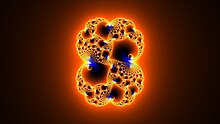Fractal generator
A fractal generator is software for the graphic display of fractals . Different algorithms are used depending on the type of fractal. The most frequently used methods are the iterated function systems , which are described by affine maps, Lindenmeyer systems or the escape time algorithm for Mandelbrot and Juliamenets .
Fast fractal generators not only calculate fixed sections, but also enable smooth zooming and "flying" in the graphic display, which is continuously recalculated.
Historical background

When the importance of fractal geometry for computer graphics technology was recognized at the end of the 1970s, the interest of graphic designers and computer scientists increased, but mathematical laypeople also took a liking to the aesthetically attractive fractals. The Mandelbrot crowd , the graphic representation of which is also known as the apple male , achieved the greatest popularity . The development of home computer technology supports the spread of corresponding software.
Well-known fractal generators
On the pc
The programs Xaos , Fractint and Fractalizer are particularly well known on the PC . The open source program Xaos is especially optimized for speed, so that you can zoom in and out in real time. Fractalizer is a German production.

Most fractal generators render the output data in 2D on an X and Y axis. With many programs you can create animations in which you can zoom in or out of the respective fractal function and move on the X and Y axes.
Another representation method is the rendering of an almond box or similar fractal algorithms on three axes in 3D . A certain fractal algorithm is also represented spatially . The most popular programs for this purpose are called Mandelbulb 3D or MB3D and Mandelbulber . With this software it is possible to create single images and animations of these spatial fractals, to save them and to prepare them for further electronic processing. In these programs, there is the possibility of setting the camera position itself in the fractal using keys and mouse navigation and of morphing different sets (i.e. rendered figures) into one another . Camera movements are made possible by setting keyframes . Depth information from the Z buffer can also be saved separately for occlusion calculations , for example in order to be further processed in other 3D software when combining various 3D animation techniques .
Other architectures
Fractal generators exist for many programmable pocket calculators on which they are often used to benchmark the system or certain parts of it. The manufacturers of pocket calculators usually offer various script languages such as Lua , Python , or system-specific assembler , proprietary languages such as TI-Basic or HP-PPL or C, both native and through modifications for programming by the user. These programming methodologies can vary significantly in their speed of execution. There were already fractal generators for older pocket calculators with a monochrome display (for example for the Texas Instruments Voyage 200 ) and comparably small hardware equipment.
Fractal generators were programmed on current graphical, programmable pocket calculators such as those from the TI-Nspire series, the HP Prime pocket calculator versions and on the computers of the French manufacturer NumWorks .




